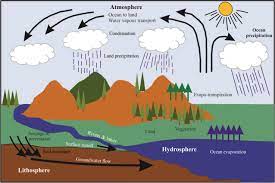
The movement of water on, above, and below the Earth’s surface is described by the hydrological cycle, sometimes known as the water cycle. It is a complex and ongoing operation. This natural mechanism is essential to the survival of life on Earth and is vital to preserving the delicate balance of the planet’s ecosystems. To appreciate the interdependence of Earth’s water supplies and the environmental processes that shape our globe, one must have a solid understanding of the hydrological cycle.
The hydrological cycle’s stages:
Evaporation: The process of evaporation starts the cycle when heat from the sun turns liquid water from lakes, rivers, seas, and even soil into water vapor. This water vapor, which is invisible, ascends into the atmosphere.
Condensation: Clouds are formed as water vapor cools and condenses to form tiny water droplets as it ascends. Precipitation formation depends on this process.
When condensed water droplets in clouds coalesce and enlarge to the point where they fall to the Earth's surface, precipitation happens. This could be hail, sleet, rain, or snow, depending on the state of the atmosphere.
Surface Runoff and Infiltration: When precipitation hits the Earth, it first experiences infiltration, which causes some of it to seep into the soil and turn into groundwater. The residual water may evaporate and create rivers and streams that eventually empty into the ocean and other bodies of water.
transpiration
The process by which plants take in water by their roots, ascend through the plant to the leaves, and then release the water vapor into the atmosphere is known as transpiration. This is a supplement to evaporation, which is also referred to as evapotranspiration.
Sublimation and Melting: Apart from evaporation, sublimation is another way that water can change straight from a solid (ice or snow) to a gas (water vapor). On the other hand, melting happens when snow or ice turns into liquid water because of increased temperatures.
The hydrological cycle's importance
Maintaining Life: Earth's hydrological cycle is essential to the continuation of life. It contributes to crop growth and ecosystem management by guaranteeing freshwater supply for humans, animals, and plants.
Climate Regulation:
The movement of water within the hydrological cycle helps regulate Earth's climate. The heat absorbed and released during the phase changes of water—evaporation, condensation, and freezing—play a crucial role in maintaining global temperature patterns.
Erosion and Sedimentation:
The cycle is a suitable agent of erosion, shaping landscapes by transporting sediments and deposits. Rivers and streams, for example, carve valleys and canyons over time through the process of erosion.
Renewable Energy Source:
Hydropower, a form of this energy, relies on the water cycle. By harnessing the energy from flowing water, it also provides a powerfull source of electricity.
Conclusion:
The hydrological cycle is an intricate dance between the atmosphere, oceans, land, and living organisms. Its movement of water sustains life, shapes landscapes, and influences climate patterns. Understanding the dynamics of this cycle is crucial for managing water resources, mitigating the impacts of natural disasters, and ensuring the overall health of our planet. As we face global challenges related to water scarcity and climate change, a comprehensive grasp of the hydrological cycle becomes increasingly important for sustainable water management and environmental stewardship.







